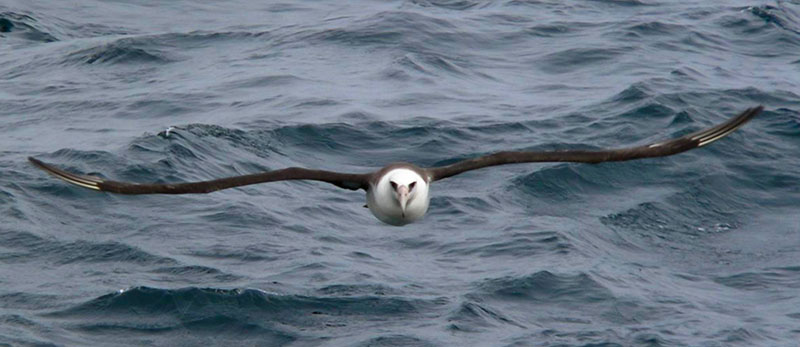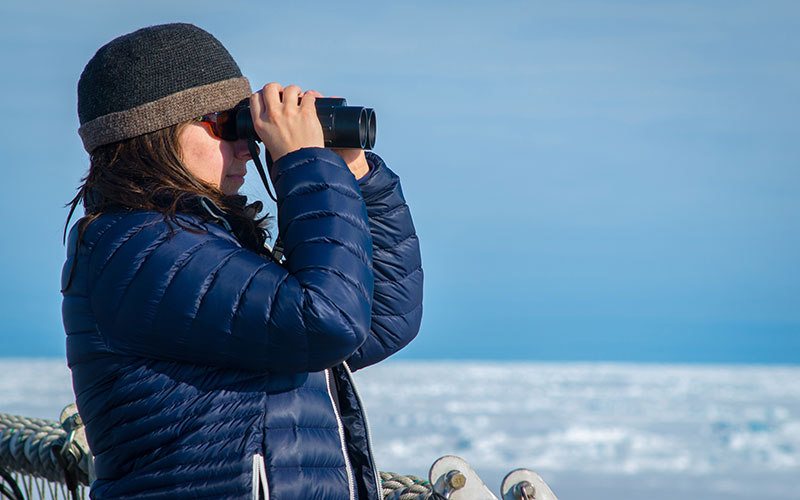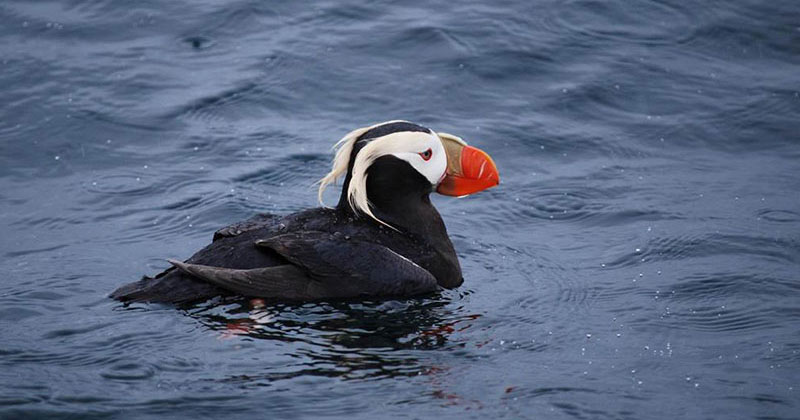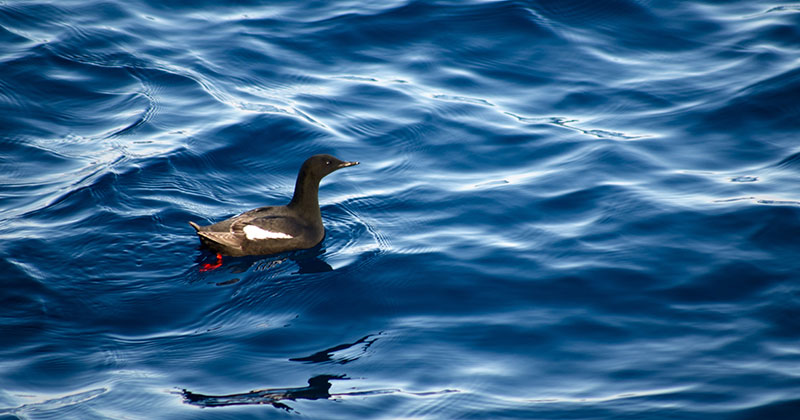
By Elizabeth Labunski, Seabird Biologist, U.S. Fish and Wildlife Service, Anchorage, Alaska
July 18, 2016

A Laysan albatross soars over the top of the water, showing off a wingspan that can measure up to 203 centimeters (80 inches). Image courtesy of Elizabeth Labunski, USFWS, The Hidden Ocean 2016: Chukchi Borderlands. Download larger version (256 KB).
Seabirds are a diverse group of birds that spend most of their lives at sea and only come to land for a short period each year to nest. Seabirds’ unique connection to the marine environment makes them excellent indicators of the marine ecosystem’s function, health, and change. Studying seabirds helps us to determine how the distribution and abundance of birds change over space and time.
While at sea, the birds spend time feeding on a variety of prey including fish, squid, euphausiids (krill), and zooplankton. Seabirds are an important part of the marine ecosystem and knowing more about their distribution can help us identify important marine habitats. This information can then be used to develop models to better understand ecosystem changes, make informed management decisions, and help further conservation efforts.

Elizabeth Labunski notes the behavior of a black guillemot at one of our science stations in the Chukchi Borderlands. Image courtesy of Caitlin Bailey, GFOE, The Hidden Ocean 2016: Chukchi Borderlands. Download larger version (2.1 MB).
The Healy has traveled across a large region of Alaska’s offshore waters, allowing us to explore and survey the diverse seabirds that occupy these regions. Seabird surveys began in Seward, Alaska, as the ship left port and have continued on through the Gulf of Alaska, Bering Sea, the Bering Strait, and now on into the Chukchi Sea. We have traveled about 3,770 kilometers or 2,035 nautical miles during the last 16 days at sea and covered varied regions and habitats on our journey.
Seabird surveys are conducted using standardized strip transect methodology. While the ship is in transit, marine birds within 300 meters (984 feet) of the vessel are counted and recorded into a data entry program running on a GPS-integrated laptop. Birds on the water or actively foraging are recorded continuously, while flying birds are recorded during periodic “snap shots” taken based on the ship’s speed.
We collect the following information for each bird observation: time, location, species, number of birds, and bird activity. We also record environmental conditions associated with each observation. These variables include weather, sea state, ice coverage, wind conditions, and observation conditions. The survey track line can also be matched with the continuous variables that the vessel is often collecting like sea surface temperature, salinity, and chlorophyll.

The tufted puffin is known for its bright yellow tufts of feathers that both sexes have during the summer breeding season. Image courtesy of Elizabeth Labunski, USFWS, The Hidden Ocean 2016: Chukchi Borderlands. Download larger version (jpg, 159 KB).

This black guillemot, a truly Arctic bird, was seen at our northern-most science station, around 77 degrees North. Image courtesy of Caitlin Bailey, GFOE, The Hidden Ocean 2016: Chukchi Borderlands. Download larger version (jpg, 2.6 MB).
During our journey, the seabird community has changed along the way. In the Gulf of Alaska, we saw many black-footed albatross, sooty shearwaters, and fork-tailed storm-petrels. As we traveled through Unimak Pass and into the southern Bering Sea, piscivorous (fish-eating) seabirds like black-legged kittiwakes, puffins, and murres became more prevalent. As the ship moved further north towards St. Lawrence and King Island in the northern Bering Sea, the piscivorous birds remained with us, but the seabird community became dominated by planktivorous (plankton-eating) auklets including the crested auklet, least auklet, and parakeet auklets. These auklet species stayed with us as we went through the Bering Strait that connects the Bering Sea to the Chukchi Sea.
As we passed into the colder waters of the Chukchi, we started spotting Arctic species as such as the black guillemot and ivory gulls. These birds can often be found foraging among the ice floes and feeding on the small Arctic cod that live under the ice. As the seabird survey continues into the Chukchi Borderlands Region, I’m looking forward to discovering what birds might be present in this unique region of the Arctic.
Want to see what it’s like to be a seabird biologist? You can practice conducting your own seabird surveys by downloading the free app, SeaScribe! The app allows you to experience what it is like to conduct surveys and collect seabird distribution data.
You can learn more about SeaScribe here .
Check out more information about seabirds in the Chukchi Borderlands here.